Financial Reporting: Analyzing Fair Value and Historical Cost Methods
VerifiedAdded on 2022/09/22
|9
|1191
|27
Report
AI Summary
This report provides a comprehensive analysis of fair value and historical cost methods in accounting, focusing on their application within the AASB framework. The report begins by defining measurement basis and then delves into the specifics of both historical cost and fair value accounting. It examines the advantages and disadvantages of each method, considering factors like relevance and reliability for financial reporting users such as investors and creditors. The report critically assesses which method, fair value or historical cost, is more relevant in accordance with the AASB framework. The report concludes that fair value method must be analysed and implemented in accounting method. It helps to analyse the current value in the market, while the historical method only analyses the previous value of the market.
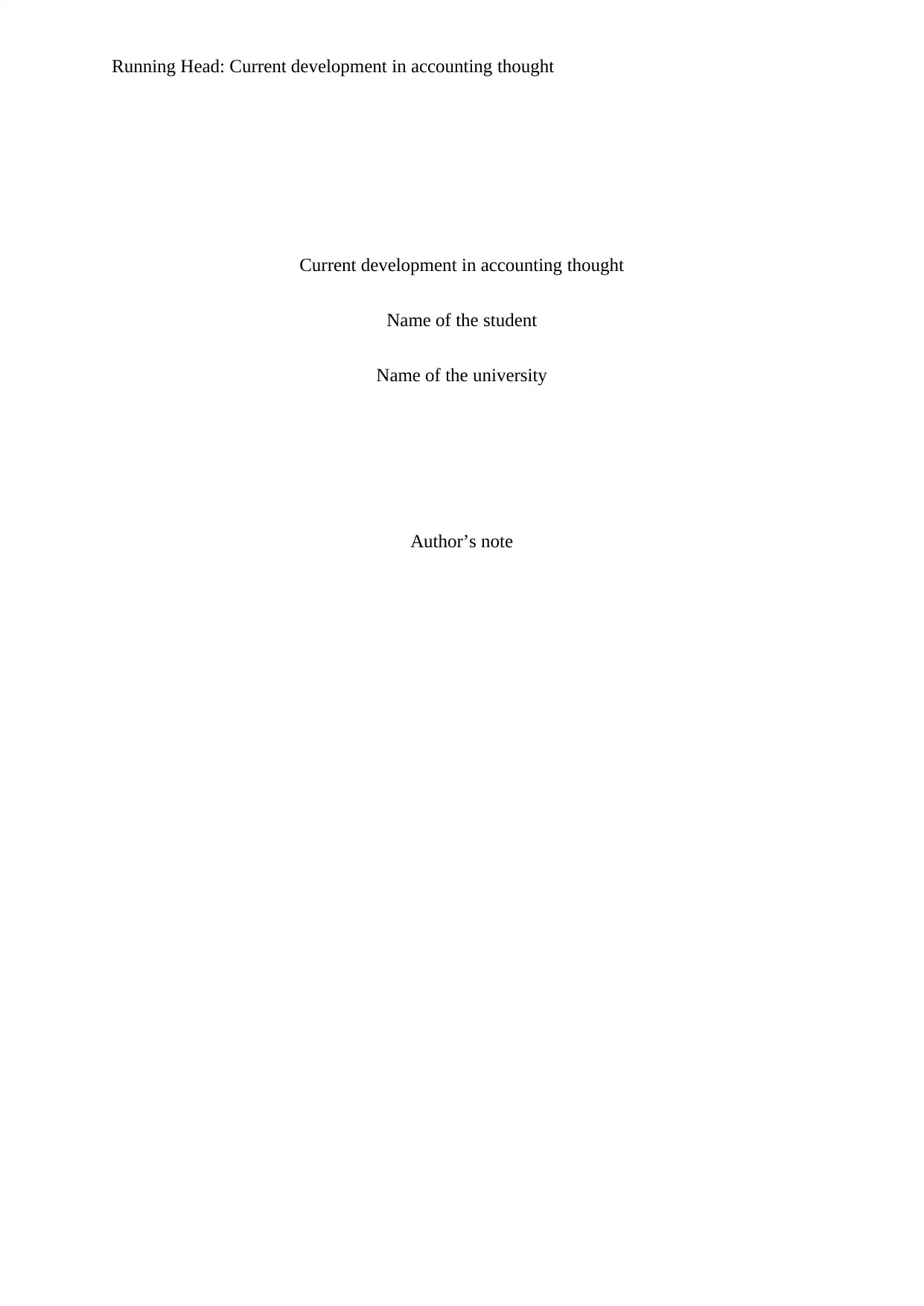
Running Head: Current development in accounting thought
Current development in accounting thought
Name of the student
Name of the university
Author’s note
Current development in accounting thought
Name of the student
Name of the university
Author’s note
Paraphrase This Document
Need a fresh take? Get an instant paraphrase of this document with our AI Paraphraser
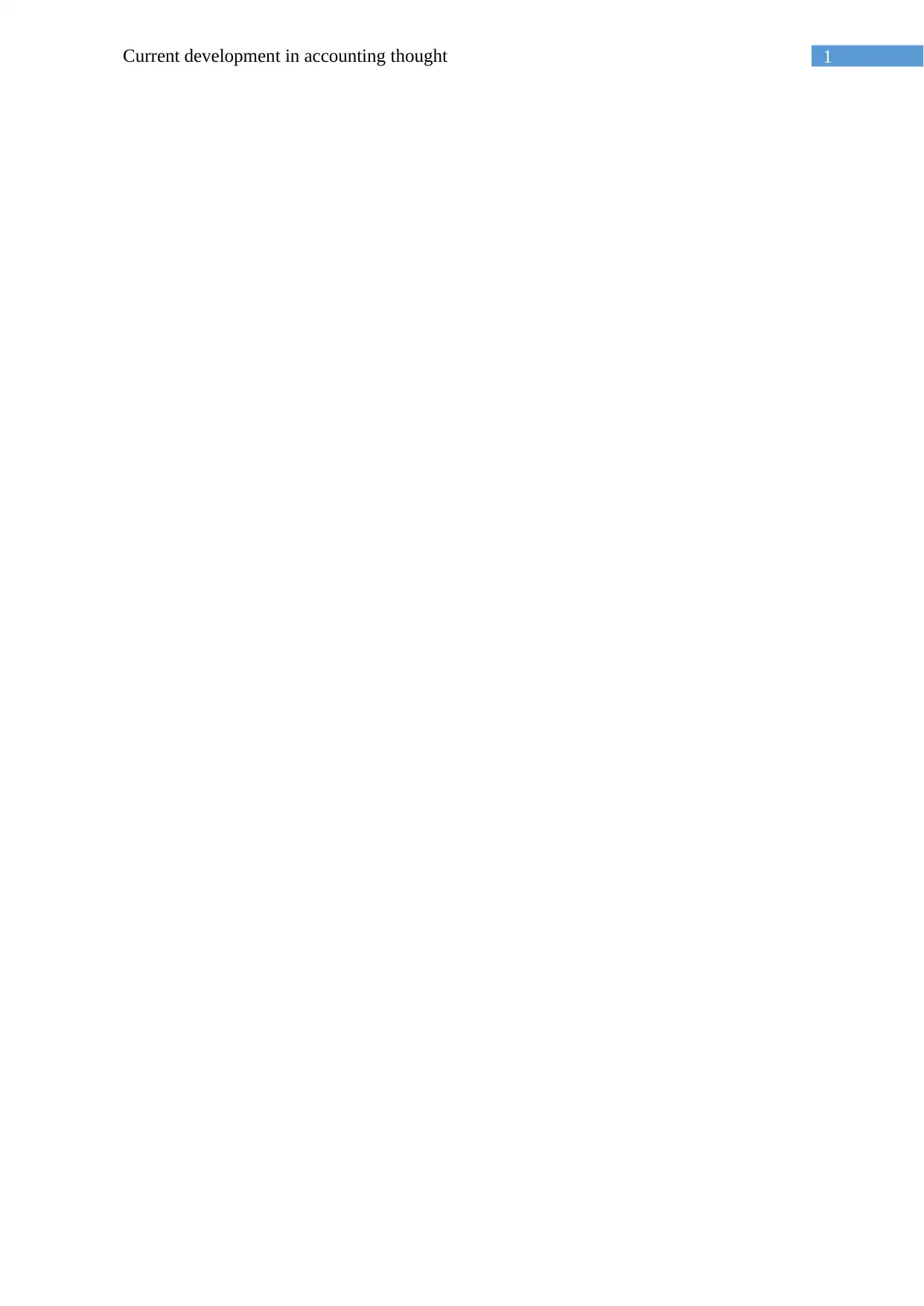
1Current development in accounting thought
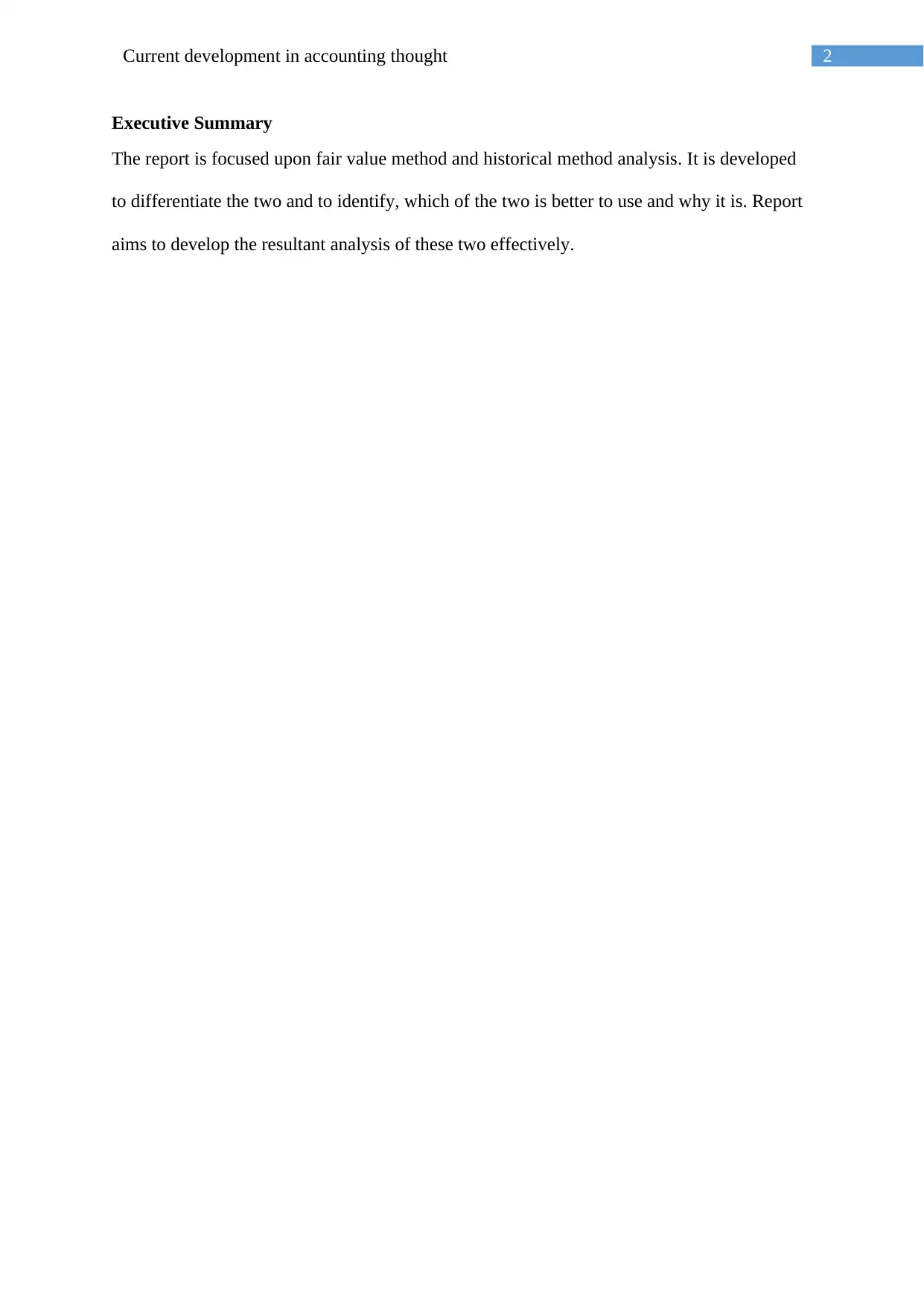
2Current development in accounting thought
Executive Summary
The report is focused upon fair value method and historical method analysis. It is developed
to differentiate the two and to identify, which of the two is better to use and why it is. Report
aims to develop the resultant analysis of these two effectively.
Executive Summary
The report is focused upon fair value method and historical method analysis. It is developed
to differentiate the two and to identify, which of the two is better to use and why it is. Report
aims to develop the resultant analysis of these two effectively.
⊘ This is a preview!⊘
Do you want full access?
Subscribe today to unlock all pages.

Trusted by 1+ million students worldwide
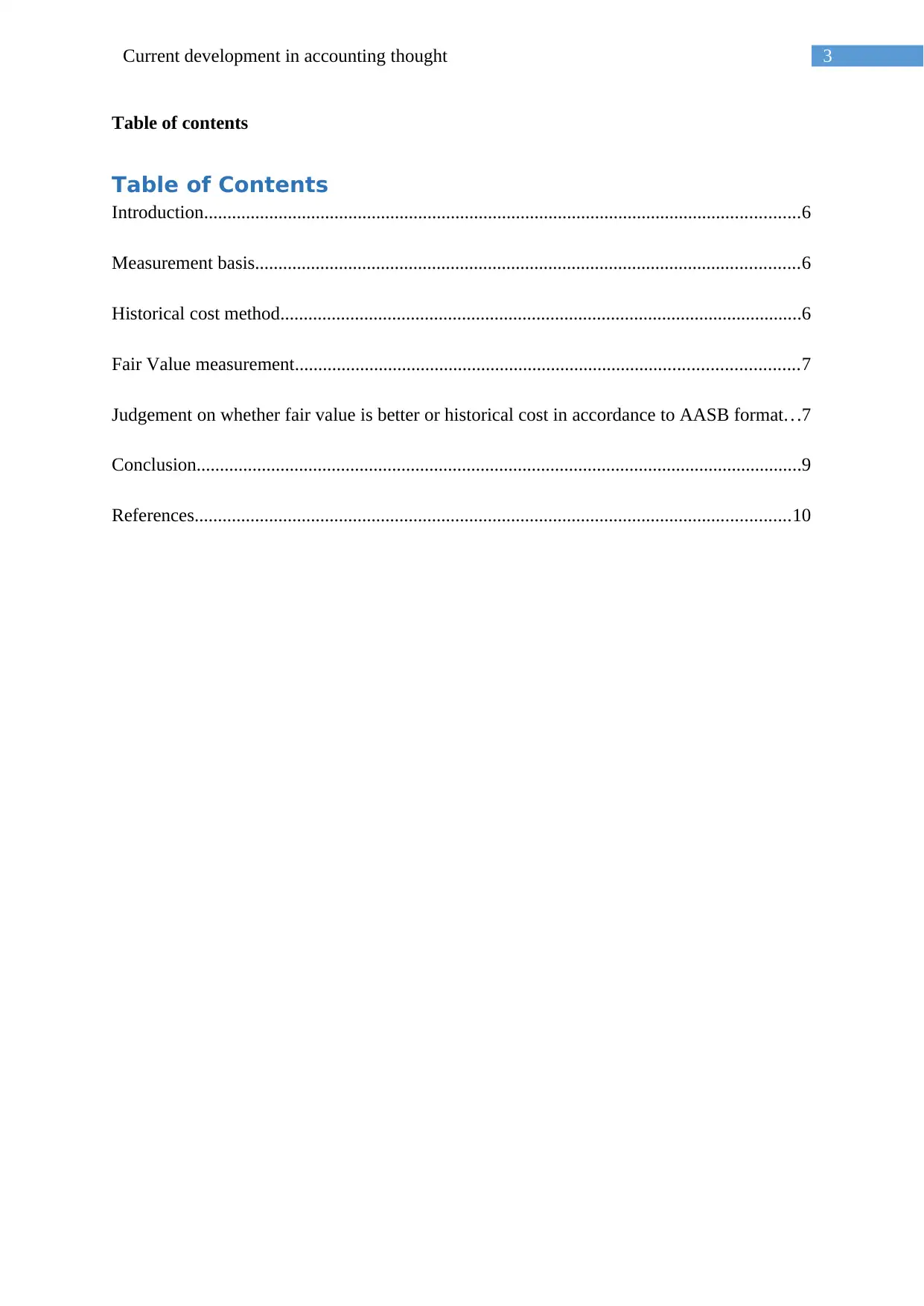
3Current development in accounting thought
Table of contents
Table of Contents
Introduction................................................................................................................................6
Measurement basis.....................................................................................................................6
Historical cost method................................................................................................................6
Fair Value measurement............................................................................................................7
Judgement on whether fair value is better or historical cost in accordance to AASB format. . .7
Conclusion..................................................................................................................................9
References................................................................................................................................10
Table of contents
Table of Contents
Introduction................................................................................................................................6
Measurement basis.....................................................................................................................6
Historical cost method................................................................................................................6
Fair Value measurement............................................................................................................7
Judgement on whether fair value is better or historical cost in accordance to AASB format. . .7
Conclusion..................................................................................................................................9
References................................................................................................................................10
Paraphrase This Document
Need a fresh take? Get an instant paraphrase of this document with our AI Paraphraser
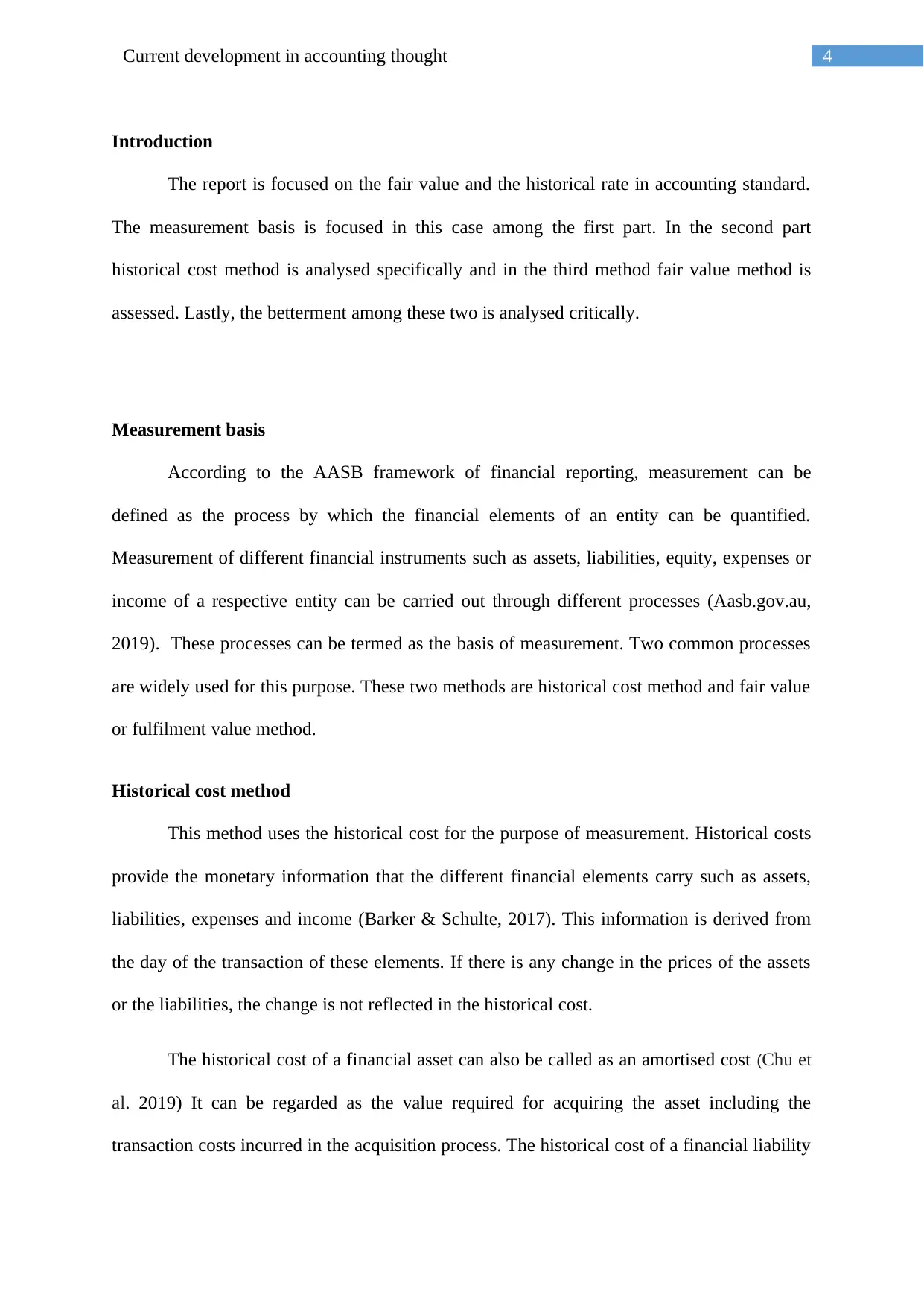
4Current development in accounting thought
Introduction
The report is focused on the fair value and the historical rate in accounting standard.
The measurement basis is focused in this case among the first part. In the second part
historical cost method is analysed specifically and in the third method fair value method is
assessed. Lastly, the betterment among these two is analysed critically.
Measurement basis
According to the AASB framework of financial reporting, measurement can be
defined as the process by which the financial elements of an entity can be quantified.
Measurement of different financial instruments such as assets, liabilities, equity, expenses or
income of a respective entity can be carried out through different processes (Aasb.gov.au,
2019). These processes can be termed as the basis of measurement. Two common processes
are widely used for this purpose. These two methods are historical cost method and fair value
or fulfilment value method.
Historical cost method
This method uses the historical cost for the purpose of measurement. Historical costs
provide the monetary information that the different financial elements carry such as assets,
liabilities, expenses and income (Barker & Schulte, 2017). This information is derived from
the day of the transaction of these elements. If there is any change in the prices of the assets
or the liabilities, the change is not reflected in the historical cost.
The historical cost of a financial asset can also be called as an amortised cost (Chu et
al. 2019) It can be regarded as the value required for acquiring the asset including the
transaction costs incurred in the acquisition process. The historical cost of a financial liability
Introduction
The report is focused on the fair value and the historical rate in accounting standard.
The measurement basis is focused in this case among the first part. In the second part
historical cost method is analysed specifically and in the third method fair value method is
assessed. Lastly, the betterment among these two is analysed critically.
Measurement basis
According to the AASB framework of financial reporting, measurement can be
defined as the process by which the financial elements of an entity can be quantified.
Measurement of different financial instruments such as assets, liabilities, equity, expenses or
income of a respective entity can be carried out through different processes (Aasb.gov.au,
2019). These processes can be termed as the basis of measurement. Two common processes
are widely used for this purpose. These two methods are historical cost method and fair value
or fulfilment value method.
Historical cost method
This method uses the historical cost for the purpose of measurement. Historical costs
provide the monetary information that the different financial elements carry such as assets,
liabilities, expenses and income (Barker & Schulte, 2017). This information is derived from
the day of the transaction of these elements. If there is any change in the prices of the assets
or the liabilities, the change is not reflected in the historical cost.
The historical cost of a financial asset can also be called as an amortised cost (Chu et
al. 2019) It can be regarded as the value required for acquiring the asset including the
transaction costs incurred in the acquisition process. The historical cost of a financial liability
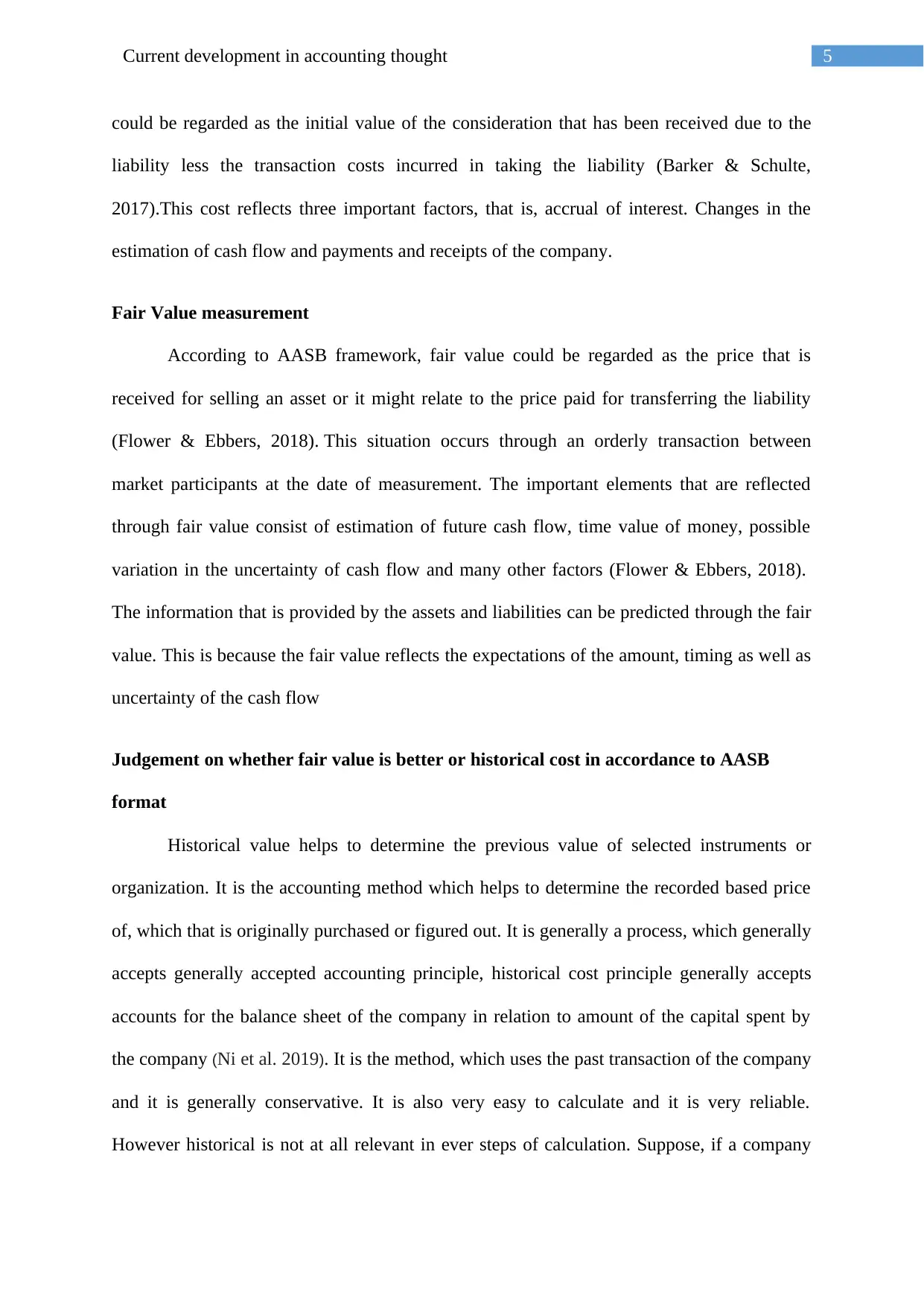
5Current development in accounting thought
could be regarded as the initial value of the consideration that has been received due to the
liability less the transaction costs incurred in taking the liability (Barker & Schulte,
2017).This cost reflects three important factors, that is, accrual of interest. Changes in the
estimation of cash flow and payments and receipts of the company.
Fair Value measurement
According to AASB framework, fair value could be regarded as the price that is
received for selling an asset or it might relate to the price paid for transferring the liability
(Flower & Ebbers, 2018). This situation occurs through an orderly transaction between
market participants at the date of measurement. The important elements that are reflected
through fair value consist of estimation of future cash flow, time value of money, possible
variation in the uncertainty of cash flow and many other factors (Flower & Ebbers, 2018).
The information that is provided by the assets and liabilities can be predicted through the fair
value. This is because the fair value reflects the expectations of the amount, timing as well as
uncertainty of the cash flow
Judgement on whether fair value is better or historical cost in accordance to AASB
format
Historical value helps to determine the previous value of selected instruments or
organization. It is the accounting method which helps to determine the recorded based price
of, which that is originally purchased or figured out. It is generally a process, which generally
accepts generally accepted accounting principle, historical cost principle generally accepts
accounts for the balance sheet of the company in relation to amount of the capital spent by
the company (Ni et al. 2019). It is the method, which uses the past transaction of the company
and it is generally conservative. It is also very easy to calculate and it is very reliable.
However historical is not at all relevant in ever steps of calculation. Suppose, if a company
could be regarded as the initial value of the consideration that has been received due to the
liability less the transaction costs incurred in taking the liability (Barker & Schulte,
2017).This cost reflects three important factors, that is, accrual of interest. Changes in the
estimation of cash flow and payments and receipts of the company.
Fair Value measurement
According to AASB framework, fair value could be regarded as the price that is
received for selling an asset or it might relate to the price paid for transferring the liability
(Flower & Ebbers, 2018). This situation occurs through an orderly transaction between
market participants at the date of measurement. The important elements that are reflected
through fair value consist of estimation of future cash flow, time value of money, possible
variation in the uncertainty of cash flow and many other factors (Flower & Ebbers, 2018).
The information that is provided by the assets and liabilities can be predicted through the fair
value. This is because the fair value reflects the expectations of the amount, timing as well as
uncertainty of the cash flow
Judgement on whether fair value is better or historical cost in accordance to AASB
format
Historical value helps to determine the previous value of selected instruments or
organization. It is the accounting method which helps to determine the recorded based price
of, which that is originally purchased or figured out. It is generally a process, which generally
accepts generally accepted accounting principle, historical cost principle generally accepts
accounts for the balance sheet of the company in relation to amount of the capital spent by
the company (Ni et al. 2019). It is the method, which uses the past transaction of the company
and it is generally conservative. It is also very easy to calculate and it is very reliable.
However historical is not at all relevant in ever steps of calculation. Suppose, if a company
⊘ This is a preview!⊘
Do you want full access?
Subscribe today to unlock all pages.

Trusted by 1+ million students worldwide
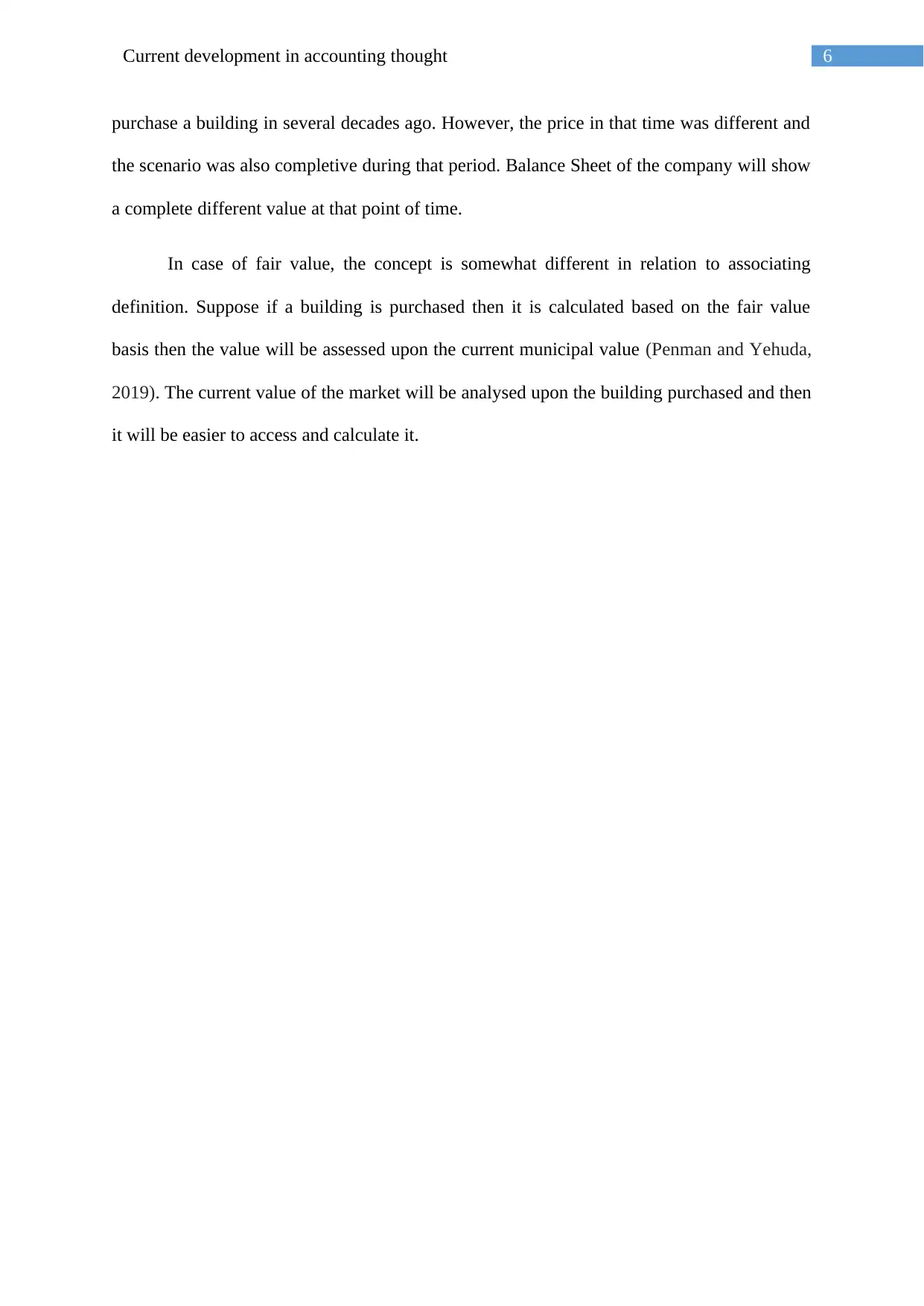
6Current development in accounting thought
purchase a building in several decades ago. However, the price in that time was different and
the scenario was also completive during that period. Balance Sheet of the company will show
a complete different value at that point of time.
In case of fair value, the concept is somewhat different in relation to associating
definition. Suppose if a building is purchased then it is calculated based on the fair value
basis then the value will be assessed upon the current municipal value (Penman and Yehuda,
2019). The current value of the market will be analysed upon the building purchased and then
it will be easier to access and calculate it.
purchase a building in several decades ago. However, the price in that time was different and
the scenario was also completive during that period. Balance Sheet of the company will show
a complete different value at that point of time.
In case of fair value, the concept is somewhat different in relation to associating
definition. Suppose if a building is purchased then it is calculated based on the fair value
basis then the value will be assessed upon the current municipal value (Penman and Yehuda,
2019). The current value of the market will be analysed upon the building purchased and then
it will be easier to access and calculate it.
Paraphrase This Document
Need a fresh take? Get an instant paraphrase of this document with our AI Paraphraser
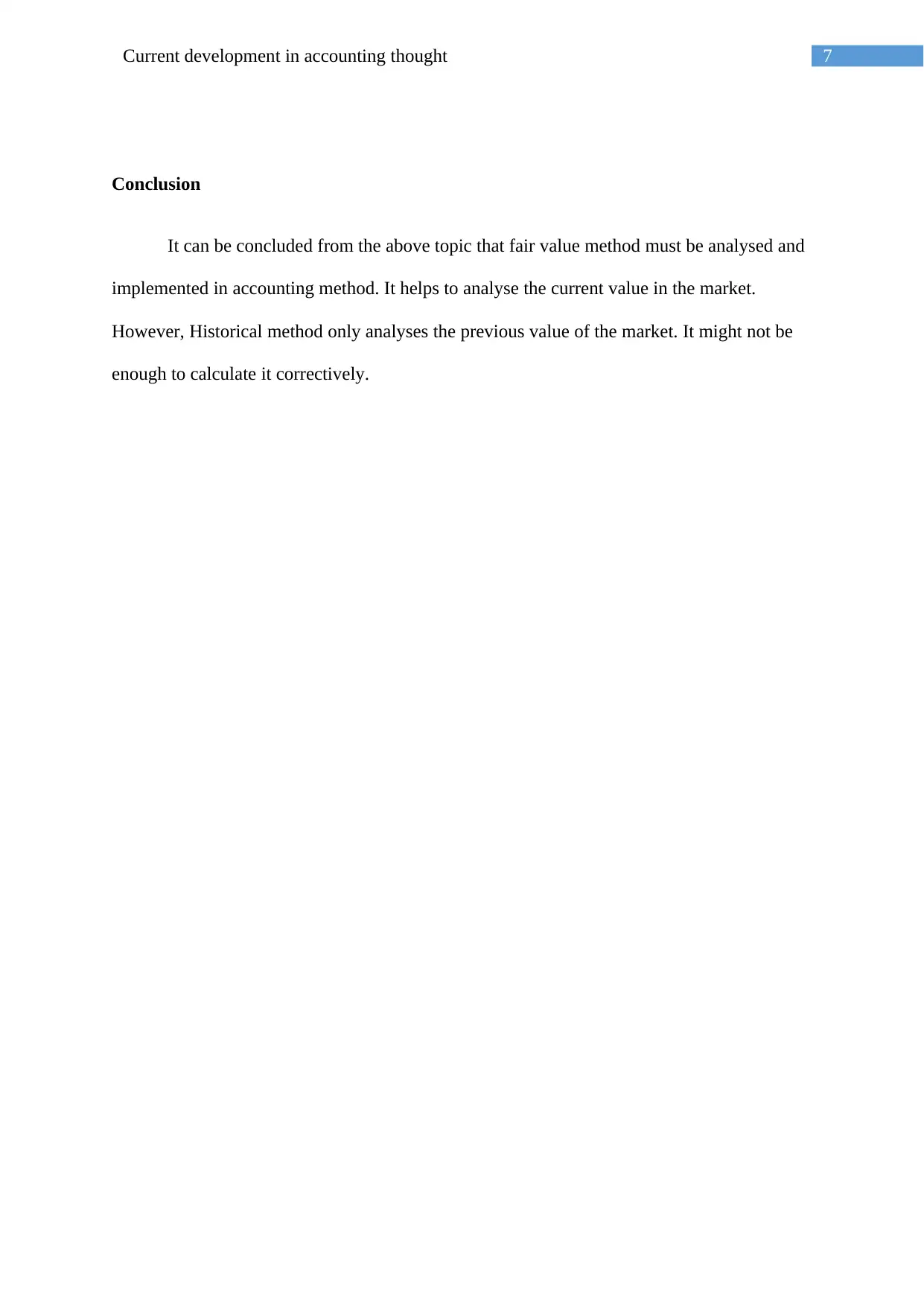
7Current development in accounting thought
Conclusion
It can be concluded from the above topic that fair value method must be analysed and
implemented in accounting method. It helps to analyse the current value in the market.
However, Historical method only analyses the previous value of the market. It might not be
enough to calculate it correctively.
Conclusion
It can be concluded from the above topic that fair value method must be analysed and
implemented in accounting method. It helps to analyse the current value in the market.
However, Historical method only analyses the previous value of the market. It might not be
enough to calculate it correctively.
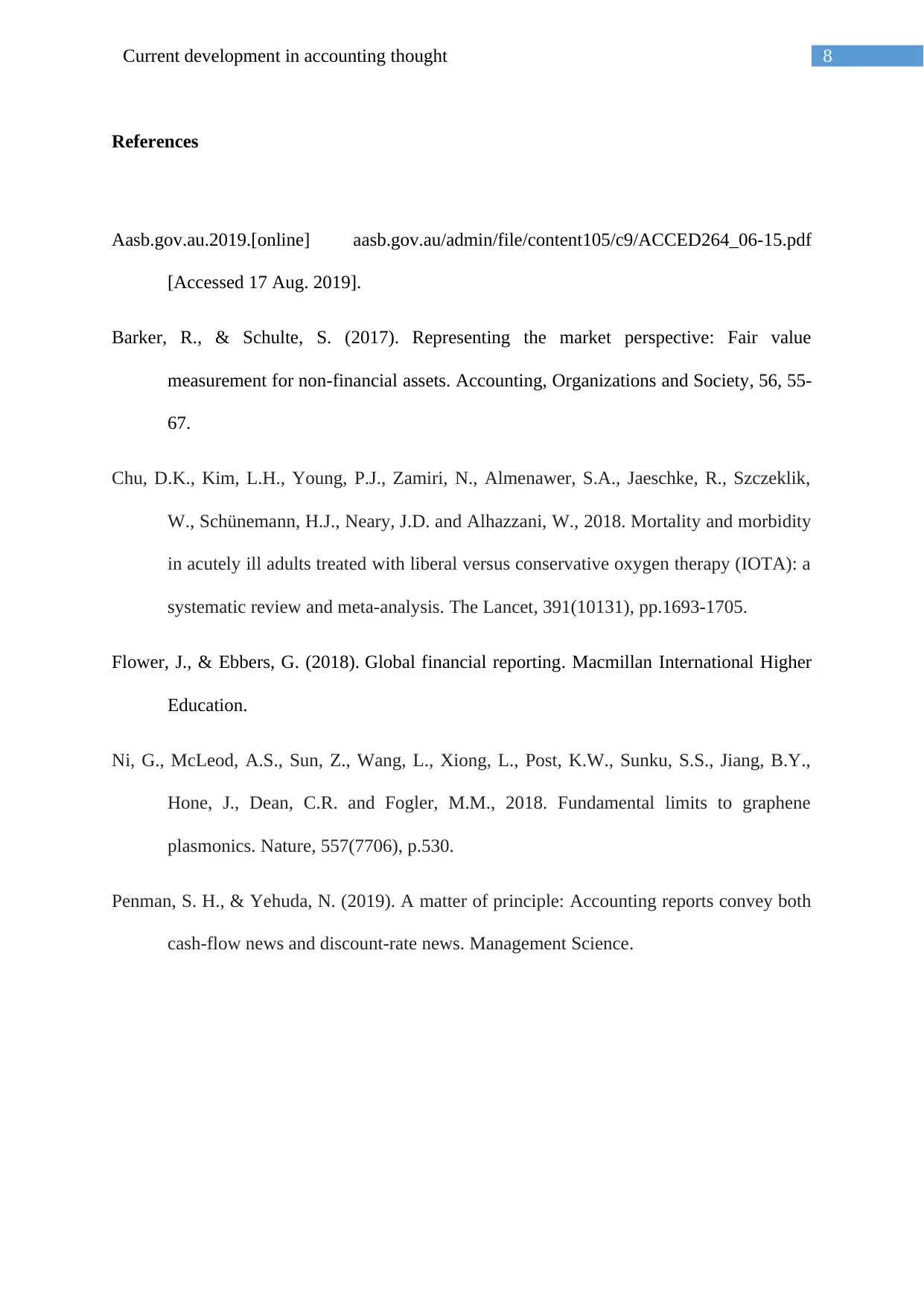
8Current development in accounting thought
References
Aasb.gov.au.2019.[online] aasb.gov.au/admin/file/content105/c9/ACCED264_06-15.pdf
[Accessed 17 Aug. 2019].
Barker, R., & Schulte, S. (2017). Representing the market perspective: Fair value
measurement for non-financial assets. Accounting, Organizations and Society, 56, 55-
67.
Chu, D.K., Kim, L.H., Young, P.J., Zamiri, N., Almenawer, S.A., Jaeschke, R., Szczeklik,
W., Schünemann, H.J., Neary, J.D. and Alhazzani, W., 2018. Mortality and morbidity
in acutely ill adults treated with liberal versus conservative oxygen therapy (IOTA): a
systematic review and meta-analysis. The Lancet, 391(10131), pp.1693-1705.
Flower, J., & Ebbers, G. (2018). Global financial reporting. Macmillan International Higher
Education.
Ni, G., McLeod, A.S., Sun, Z., Wang, L., Xiong, L., Post, K.W., Sunku, S.S., Jiang, B.Y.,
Hone, J., Dean, C.R. and Fogler, M.M., 2018. Fundamental limits to graphene
plasmonics. Nature, 557(7706), p.530.
Penman, S. H., & Yehuda, N. (2019). A matter of principle: Accounting reports convey both
cash-flow news and discount-rate news. Management Science.
References
Aasb.gov.au.2019.[online] aasb.gov.au/admin/file/content105/c9/ACCED264_06-15.pdf
[Accessed 17 Aug. 2019].
Barker, R., & Schulte, S. (2017). Representing the market perspective: Fair value
measurement for non-financial assets. Accounting, Organizations and Society, 56, 55-
67.
Chu, D.K., Kim, L.H., Young, P.J., Zamiri, N., Almenawer, S.A., Jaeschke, R., Szczeklik,
W., Schünemann, H.J., Neary, J.D. and Alhazzani, W., 2018. Mortality and morbidity
in acutely ill adults treated with liberal versus conservative oxygen therapy (IOTA): a
systematic review and meta-analysis. The Lancet, 391(10131), pp.1693-1705.
Flower, J., & Ebbers, G. (2018). Global financial reporting. Macmillan International Higher
Education.
Ni, G., McLeod, A.S., Sun, Z., Wang, L., Xiong, L., Post, K.W., Sunku, S.S., Jiang, B.Y.,
Hone, J., Dean, C.R. and Fogler, M.M., 2018. Fundamental limits to graphene
plasmonics. Nature, 557(7706), p.530.
Penman, S. H., & Yehuda, N. (2019). A matter of principle: Accounting reports convey both
cash-flow news and discount-rate news. Management Science.
⊘ This is a preview!⊘
Do you want full access?
Subscribe today to unlock all pages.

Trusted by 1+ million students worldwide
1 out of 9
Related Documents
Your All-in-One AI-Powered Toolkit for Academic Success.
+13062052269
info@desklib.com
Available 24*7 on WhatsApp / Email
![[object Object]](/_next/static/media/star-bottom.7253800d.svg)
Unlock your academic potential
Copyright © 2020–2025 A2Z Services. All Rights Reserved. Developed and managed by ZUCOL.





